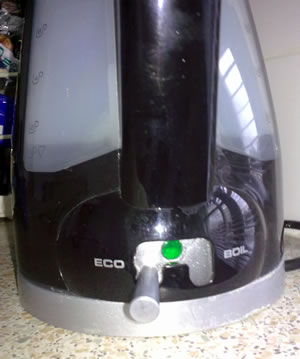Achieving simplicity through double duty
Clever designers often simplify by making one component serve several purposes.
So says Giles Colborne in Simple and Usable, citing as an example the heating element in car rear windshields which often also function as the radio antenna.

In my kitchen I noticed another example of "double duty" design used effectively to make things simpler.
"Eco" kettles
Our previous Philips kettle let you choose the water temperature via a "Set Temp." button which toggled between four options ranging from 40° to boiling. Once you'd set the temperature you then pressed the on/off button to start/stop heating.
It also featured a "keep warm" function which maintained the water at your chosen temperature after the initial heating had finished. Clever, if not particularly useful (to me at least) or power saving (what if you forget to turn it off?).

The Morphy Richards kettle we now use has less functionality than the Philips, but it still allows you to save electricity by heating to a lower temperature when boiling isn't required, for example when making coffee ("Coffee boiled is coffee spoiled"), herbal teas, hot-water bottles etc.
Instead of two separate buttons for setting the temperature and switching on the kettle, there's just one control for both operations: a lever which you pull downwards either into a groove on the left to start "eco" heating (85°), or another on the right for full boil.
The Philips model probably needs the separate buttons because of the Keep Warm feature, but without that you could perhaps imagine each temperature option being a button which you press to start the kettle with that setting. But then it might be less clear how to switch on, or stop the heating manually - most people expect an obvious ON/OFF button.
The Morphy Richards kettle's mechanical lever is a wonderfully simple solution and presumably makes the appliance cheaper to manufacture and less prone to faults.